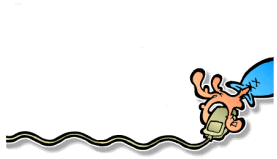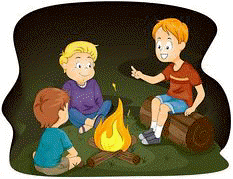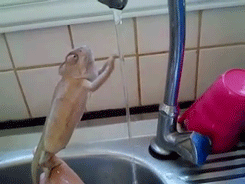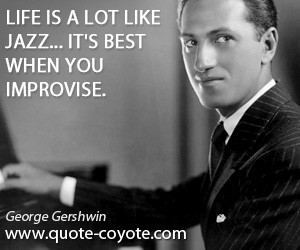Technology in the Music Classroom 
Lecture: Creating
|
Creating music
is the first standard. We tend to think mostly of
composing music (writing it down in standard notation).
But there are many ways to create music:
one involves notation, but there are other strategies.

For example, I can compose a story, writing it down as I go.

Or, I can compose a story without writing it down and just
remember it to tell it again. Or, I can tell a story,
making it up as I go. I can take a story that is already
written and make changes in it, making it more detailed and
elaborate or changing it from serious to funny. What if I
take elements from several stories and mash them up into one
story or just take one element from a familiar story and build a
whole new story around it?
Can you see the
similarity to creating music?? Creating music may be done
in many ways; music literacy is writing it down.
Many of us did not
get much training in CREATING MUSIC. We were too busy
getting schooled in performing in ensembles, how to practice,
chords/scales/key signatures, history of music, music
literature, World music (if we were lucky - I didn't get that),
sight-singing, ear-training, marching band drills, performance
practice, diction, music education, general education courses
and the list goes on and on and on and on . . . .
Creating music was really for the
brainiacs who did it on their own time, right?
We can't possibly expect our students
to create music when we didn't really learn to do it ourselves,
right?
We don't have the time anyway, right?

Ummmmmm . . . . . . IT's THE
FIRST STANDARD!!!
  
Important:
Creativity is not the same as creating original music. For
example, you may be creative in your interpretation of a
Beethoven sonata, but that is not creating original music.
For the purposes of this week's assignment
and the "Creating Music" part of the Standard, the student
should be creating original music. This
includes improvisation, composition, and arranging (not
transcribing) |
|
| |
|
|
Kashub and Smith (2009): Five-Point rationale for why all
children should be able to study composition.
1. Challenges students to consider their understanding of the
world in new ways.
2. Allows children to exercise their generative potential in
music.
3. Develops a way of knowing that complements understandings
gained through other direct experiences of music
4. Invites the child to draw together the full breath of his or
her musical knowledge.
5. Is the process that allows the child to grow, discover, and
create for him or herself through artistic and meaningful
engagement with sounds.
If you don't have time for that, I wash my
hands of you.

|
|

|
Creating
Imagine:
Generate musical ideas for various purposes and
contexts.
Plan and
Make: Select and develop musical ideas for defined
purposes and contexts.
Evaluate
and Refine: Evaluate and refine selected musical
ideas to create musical work that meets appropriate criteria
Present:
Share creative musical work that conveys intent,
demonstrates craftsmanship, and exhibits originality.
Objective:
Composing music
Technology: Music writing software
(Finale, Sibelius, NotePad, Noteflight, Musescore)
|

Note: Programs listed in
parentheses are only examples. Use
your browser to search by name for more
information on these programs. You
may want to add them to your links.
Find other programs by searching for
"alternatives to *fill in name of
similar program*" There are also
hundreds of mobile apps. Search by
the name of the activity (compose,
improvise, loop, record, etc.).
Do not limit yourself to these very
common examples! |
Encourage
and apply music literacy
Activities:
-
Write music traditionally
-
Transpose music to different keys
-
Listen to what has been written
Technology: Creating/recording software
(Garage Band, Mixcraft, Soundation,
Incredibox)
Creation
can happen without music literacy (http://www.musiccreativity.org)
Activities:
-
Mix, compose, record music using software
instrument tracks
-
Live instrument tracks
-
Loops of prerecorded clips of music
as a compositional base
Objective:
Improvising music
Technology: Accompanying software (SmartMusic,
loops, MusiClock, Band-in-a-Box, Beatlab)
Activities:
-
Jam with background
tracks
-
Experiment improvising
with loops or drum sounds
-
Create chord progressions/harmony for
improvisation exploration
Technology: Experimenting software (SmartMusic
[to slow the track], Transcribe, recording apps)
Activities:
-
Manipulate sounds using
synthesizers and other electronic
instruments, and sound production apps
-
Recording can "capture"
improv to play back, save, and make
improvements
-
Mobile devices can become
their own instruments with apps
|
|
| |
|
 |
|
7-Level Sequential Model for
the Development of Improvisational Abilities
(text p. 52)
Level 1: Exploration, A pre-improvisatory level in which student
tries out various sounds without any particular structure.
Level 2: Process-oriented improvisation, true improvisation
begins, students have some control over the process coordinating
motor skills with intentionally created sound patterns, patterns
that are often repeated.
Level 3: Product-oriented improvisation, student becomes more
aware of musical structures like tonality, meters, tempo,
harmonic changes, and phrases and utilizes these in
improvisation which allows listeners to derive greater meaning
from them.
Level 4: Fluid improvisation, student exhibits more control and
automaticity over technical aspects of performance being able to
sing/play without consciously thinking about it with greater
fluidity in keys, meters, and tempos.
Level 5: Structural improvisation, student utilizes larger
musical structures when improvising and uses techniques such as
development of melodic ideas, tension and release, and
connections among musical ideas within an improvisation.
Level 6: Stylistic improvisation, student is able to fluently
improvise within a particular style, utilizing appropriate
melodic, harmonic, and rhythmic devices.
Level 7: Personal improvisation, The ultimate achievement
is for a musician to develop a unique, recognizable style of
improvisation. Teachers can encourage students to become
fluent in a wide range of styles, which may over time meld into
an innovative stylistic approach.
There are many
activities that can inspire students to improvise.
Technology tools can produce interesting sounds that can be
manipulated or combined. Those sounds can then be
recorded.

Using Technology to Unlock Musical
Creativity by Scott Watson is an excellent
resource for this very important Standard!
In his book, he cites 8 principles for "successfully drawing
out student creativity" which form the basis for his book.
They are:
|
1. Allow students to share themselves
2. Offer compelling examples to imitate and
inspire
3. Employ parameters and limitations that
remove distractions and help students focus
4. Remove parameters and limitations that
stifle creativity and lead to contrived expression
5. Facilitate improvisation
6. Engage in coaching interaction
7. Foster opportunities for feedback and
critique
8. Employ performance and recital |
Keep these in mind as you consider ways to add Creating Music to
your classroom!
 |
|

Created and maintained by Vicky V. Johnson |
|